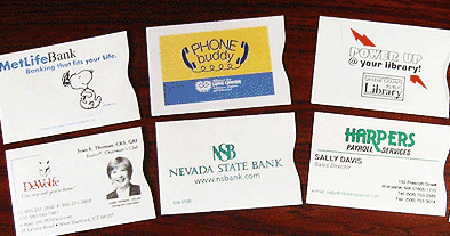
Using Your (small) Size as a Competitive Advantage
Are you ever frustrated or hesitant when you talk to prospective customers because you can’t readily explain why they should come to you rather than go to your competitors? Sure, you might have your 30-second elevator speech, but then they ask you that dreaded question, “So what makes you different?” Then, all those self-doubts creep in, and you just aren’t sure what to say. Differentiation can boost confidence–yours in yourself and that prospective customer’s confidence in you!
Dif-fer-en-ti-ate v. tr. To perceive or show the difference in or between; discriminate.
In business terms, to differentiate means to create a benefit that customers perceive as being of greater value to them than what they can get elsewhere. It’s not enough for you to be different–a potential customer has to take note of the difference and must feel that the difference somehow fits their need better. (Other words that mean virtually the same thing: Competitive Advantage; Unique Selling Proposition; or Value Proposition.)
As you are building your business, you can use differentiation to attract more customers. Once you have momentum, differentiation allows you to charge a higher price because you are delivering more value to your customers. Make a point to evaluate and adjust your differentiation methods at least annually.
The various methods of differentiating your businesses fall into four general categories:
Price Differentiation
Focus Differentiation
Product/Service Differentiation
Customer Service Differentiation
Price Differentiation
Differentiating on price is probably the most common and easily understood method. HOWEVER, for Solo Entrepreneurs, caution is in order. On the one hand, potential customers might expect a lower price from you than from your larger competition because they perceive you as having less overhead, etc. On the other hand, cheaper prices can evoke perceptions of lower quality, a less-stable business, etc. And if you compete on price against competitors with deeper pockets, you can price yourself right into bankruptcy. Be creative with this differentiator by competing on something other than straight price. For example, you might offer:
- More value–offer more products or services for the same price.
- Freebies –accessories, companion products, free upgrades, and coupons for future purchases.
- Free shipping, etc.–convenience sells, especially when it is free!
- Discounts–includes offering regular sales, coupons, etc. (see cautions above)
Focus Differentiation
For Solo Entrepreneurs, this is the most important method of differentiation, and in many ways, the easiest. Why? Because as a Solo Entrepreneur, you simply can’t be everything to everybody, so you must pick a specific way to focus your business. Once you have done that, you have an automatic advantage over larger companies because you can become more of an expert in that one field –and you can build close relationships with key customers that will be hard to duplicate. For example, you might differentiate yourself through:
- Location–take advantage your closeness to prospective customers.
- Customer specialization–be very specific about what characteristics your customers will have – for example, racing bicycle enthusiasts or companies with a spiritual conscience.
- Customer relationships–know customers really well, form partnerships with them, and get them to speak for you!
- Affinity relationships–associate your product/service with a well-known person or organization.
- One-stop shopping–offer everything your target market needs, in your area of expertise.
- Wide selection (within your niche) – although this one may seem to be the opposite of focus–the key is to be very specific in one dimension and very broad in another.
Product/Service Offering Differentiation
How much you are able to differentiate your product or service offering will vary based on what type of business you are in. For instance, if you are in a highly regulated business, your options may be limited. Explore a totally new market or type of product or service, however, and the possibilities abound. The key to successful differentiation in this category, again, is to know your customers, really, really well. Talk to them often, and you will know what they need most and be able to offer it, long before your competitors know what is happening. For example, your product or service could stand out in one of these ways:
- Quality–create a product or service that is exceptional in one or more ways.
- Lasts longer
- Better features
- Easier to use
- Safer
- New/First–be the first one to offer something in your location/field.
- Features/Options–offer lots of choices, unusual combinations, or solve a problem for a customer in a way no one else does.
- Customization–as a Solo Entrepreneur, you may be able to more easily handle special orders than big, mass-market competitors.
Customer Service Differentiation
Have you noticed how customer service seems to be out of vogue these days? This situation makes excellent customer service a great opportunity for differentiation and another natural advantage for Solo Entrepreneurs that already know what’s important to their customers. Build your reputation on making customers feel really good about doing business with you. Works great with referral marketing, too. Examples:
-
Deliver Fast–next day, or one-hour–make it faster than customers think possible.
-
Unique channel–offer a service over the phone or Internet instead of in person or in their office rather than yours.
-
Service-delight customers!–it may seem expensive to offer exceptional service–but it pays off in word-of-mouth advertising.
-
Before/during/after-sales support–provide technical or other support to customers using your product. You might use joint ventures to provide that support–but customers will perceive it as being from you!
-
Guarantee/warranty–offer 100% money-back, or free replacement parts.
-
YOU–offer yourself, your unique blend of talents and skills, to attract customers. Make sure they get access to you, too!
Keys to Successful Differentiation:
-
Know your customers, really, really well.
-
Pick a blend of differentiation methods that, in the eyes of your customers, truly sets you apart.
-
Talk about your differentiation in terms of customer benefits.
-
Tell everyone about what differentiates you–often.
-
Keep your differentiation fresh by listening for changing customer needs.

 Lou Bortone is an award-winning writer and video producer with over 20 years experience in marketing, branding and promotion. As an online video expert, Lou helps entrepreneurs create video for the web at www.TheOnlineVideoGuy.com. In addition, Lou works as a freelance writer and professional ghostwriter, with a ghostwriting site at www.GhostwriteForYou.com and a blog at www.GhostwriteGuru.com.
Lou Bortone is an award-winning writer and video producer with over 20 years experience in marketing, branding and promotion. As an online video expert, Lou helps entrepreneurs create video for the web at www.TheOnlineVideoGuy.com. In addition, Lou works as a freelance writer and professional ghostwriter, with a ghostwriting site at www.GhostwriteForYou.com and a blog at www.GhostwriteGuru.com. It’s a dilemma that most small businesses and startups face: You must market and advertise, but you’re strapped for cash. Fortunately, ideas, energy and imagination can make up for meager marketing budgets. Whether you’re an established company or a nascent business, the marketing formula is the same. You’ll need to start with:
It’s a dilemma that most small businesses and startups face: You must market and advertise, but you’re strapped for cash. Fortunately, ideas, energy and imagination can make up for meager marketing budgets. Whether you’re an established company or a nascent business, the marketing formula is the same. You’ll need to start with: Celebrity endorsements are a staple in advertising, with more than 20 percent of all ads today featuring a famous face, voice or likeness. Even smaller businesses are using celebrity spokespersons. The reason is simple: Celebrities sell. Consumers pay attention to celebrities because they are attracted to the familiar. But celebrities don’t have to be major national names. Local and regional “celebrities” can also help pitch a marketing message for your small business. Three ways your business can use a celebrity spokesperson are:
Celebrity endorsements are a staple in advertising, with more than 20 percent of all ads today featuring a famous face, voice or likeness. Even smaller businesses are using celebrity spokespersons. The reason is simple: Celebrities sell. Consumers pay attention to celebrities because they are attracted to the familiar. But celebrities don’t have to be major national names. Local and regional “celebrities” can also help pitch a marketing message for your small business. Three ways your business can use a celebrity spokesperson are: